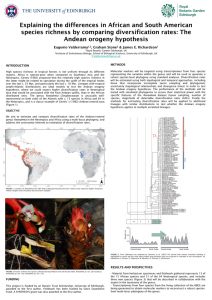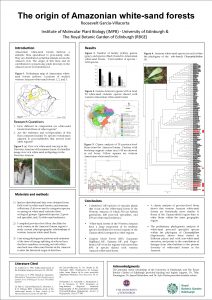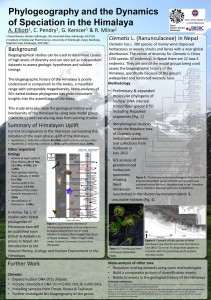As part of a PhD programme in the School of Biological Sciences at Edinburgh University students are expected to create and present a poster at the end of their 2nd year. The poster session, as well as being as assessed piece of work, is chance for other students and research staff who might not ordinarily engage with your project to get a glimpse at what you’ve been doing and what you’ve found so far. It also helps provide valuable evidence that you haven’t spent the best part of 24 months drinking coffee and swanning about.
As well at the obvious need to pass the hope is that fresh eyes and ideas may point you to new avenues of research and possibly lead to collaborative opportunities in the future. It’s also meant to give us the chance to show what skills we’ve acquired, what our research interests are and hopefully how capable we are becoming. All too important as there might be some senior researchers lurking around who might employ us when it’s time to start looking for an elusive postdoc.
The three RBGE students contribution this year were:
 Explaining the differences in African and South American species richness by comparing diversifications rates: The Andean orogeny hypothesis.
Explaining the differences in African and South American species richness by comparing diversifications rates: The Andean orogeny hypothesis.
Eugenuio Valderrama
The Neotropics are considered one of the most diverse regions of the already diverse tropical forests. I aim to test whether high neotropical species richenss can be explained by higher (relative to other regions) phylogenetic diversification rates associated with speciation during uplift of the tropical Andes of the last ca. 25my, and particularly the last 10my. We estimate and compare diversification rates of the Andean-centred genus Renealmia in the Neotropics and Aftrica using a multi-locus phylogeny, and address the uncertainty inherent to estimation of diversification rates.
Origin of Amazonian White-Sand Forests: A distributional and Molecular Approach.
Roosevelt Garcia Villacorta
Amazonian white-sand forests harbor a specialised and endemic flora distributed as habitat-islands. The origin and contribution of this flora to present-day plant biodiversity in the Amazon is not well understood. I am using a geographical distribution analysis of white-sand species to understand its current relationships with other regions in tropical America. To gain insights into the historical evolution of these forests, a selected set of taxa from white-sand forests are being investigated using molecular phylogenetic approaches. I present here preliminary results from both analyses and interpret them under the light of current and historical development of the Amazon flora.
Find out more about about Roosevelt
https://sites.google.com/site/rooseveltgarcia/
Phylogeography and the Dynamics of Speciation in the Himalaya.
Alan Elliott
Investigations into the phylogeography of the Himalaya are in their infancy with a limited number of studies focusing on Himalayan groups and a number of other studies with limited Himlayan representation. This is in marked contrast to the Andes where meta-analysis of more fifty dated phylogenies has given important insights into the assemblages of the biota of this other region of mega diversity.
The poster is based on initial results of the current study into the diversity of Clematis L. and on Elliott and Adhikari (in press), a review of available literature, to draw insights into the role of the Himalayan uplift in generating diversity.
